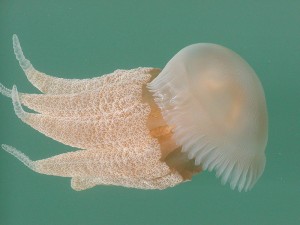Jellyfish are beautiful swimming jelly like creatures that have an umbrella shaped bell as their bodies and long tentacles attached to them. When the bell pulsates slowly, it helps the jellyfish move from one place to another place. Their bell shaped bodies expand and contract to push water behind them.
They use their stinging tentacles for hunting. They sting and paralyse their prey before they eat them. Not all jellyfish can cause a serious reaction to us. If jellyfish touches us it will cause discomfort for some of us. Some will have no effect from the stings but for some will find the stings to be very painful and unfortunately some will even die from the stings. Beware of dying jellyfish, they can still sting when you touch them. Most jellyfish stings are not deadly, but stings from some species like box jellyfish and toxic Irukandji jellyfish can be deadly. For example, the sea wasp, a box jellyfish which live in Australian seas is capable of killing an adult human within a few minutes. Vinegar can be used to treat jellyfish stings.
You can find jellyfish in every ocean, from the surface to the deep ends of the sea. Most of the time you will be able to find colourful jellyfish at the coast of the sea. It is possible that jellyfish have existed for 700 million years or more. They have no backbones. They are often see through, for example, box jellyfish are almost see through. A group of jellyfish is called ‘bloom’, ‘swarm’ or ‘smack’. There will be normally about hundreds or thousands of jellyfish in a large blooms. They are not fish although the word ‘fish’ is part of their name. They don’t have brains, so I suspect that they are not very clever creatures. They do not have a breathing system like us because their skin is thin enough to let oxygen in. They have limited control of their movement. Some jellyfish are very active and some of them aren’t. Between 95% and 98% of their bodies are water. That is a lot of water. We have only between 50% and 75% water in our bodies.

Some jellyfish’s eyes respond to the sunlight shining on the surface of the water. Their eyes do not form images. Box jellyfish have a better eye sight compared to other jellyfish. They have 24 eyes and two of the eyes are capable of seeing colour. So they are not colour blind.
Jellyfish can have a bell shaped body which is about 1 mm in diameter to nearly 2 m in diameter. The smallest jellyfish are crawling jellyfish. They have a small tiny bell that is from 0.5mm to a few mm in diameter. This tiny mini jellyfish can be found on seaweed or at the bottom of the rocky pools. They are so tiny. You can’t actually see them unless you have a hand lens or microscope. There is another small very poisonous jellyfish which is called Irukandji. It is only the size of a fingernail. It can be found in Australian seas.
Apart from the tiny mini jellyfish, there is a very huge one. It is called Lion’s Mane jellyfish. It is the largest jellyfish in the ocean and it is longer in length compared to the blue whale. They have thread-like tentacles which can extend up to 36.5m. The stings are reasonably painful but you will not die from their stings.
You will be amazed to find that some jellyfish can only live for a few hours especially the small ones. Others can live for several months. The larger coastal jellyfish normally live 2 to 6 months.
Jellyfish eat plankton, fish eggs and other jellyfish. On the other hand tuna, sharks, swordfish and sea turtles eat jellyfish. The number of jellyfish have increased over the years because most of their predators have been caught by excessive fishing activities.
Some jellyfish live in freshwater. For example, the Small Cosmopolitan Freshwater Jellyfish which is less than 2.5cm in diameter and colourless. The good news is they do not sting. Most of them live in the ocean.
In Japan and Korea, jellyfish are known as a delicacy. Beware, not all jellyfish are edible. The main problem with jellyfish is they make it very unpleasant to swim in the sea. This will have a very negative effect on the tourism industry. They also cause a serious problem to the fisheries industry because they tend to destroy the fishing nets, capture the fish and eat up the eggs and the baby fish. They are capable of clogging up the cooling equipment and disable power station in some countries.